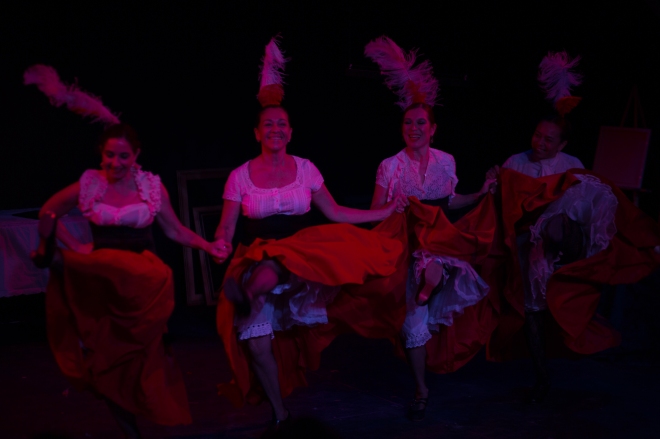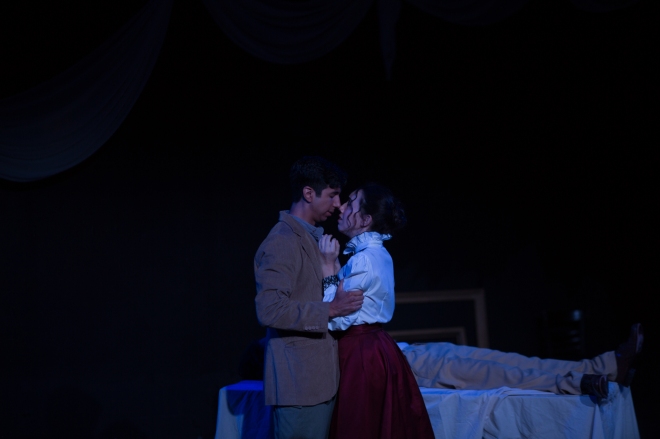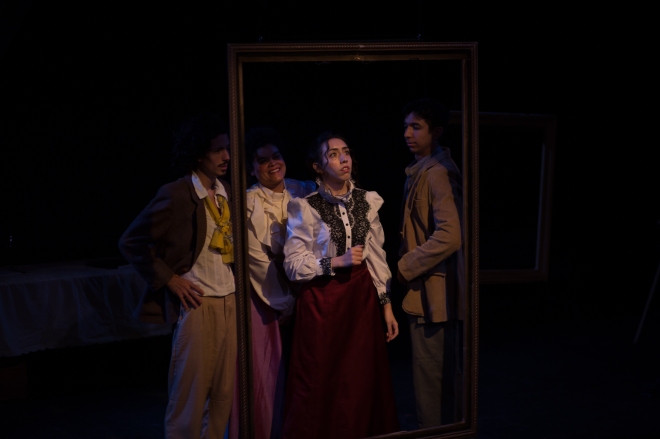Two women, Inez Korff and Liliana Ruiz, in traditional black dresses dance the fiery flamenco. No music is even necessary because their feet beat the rhythm in a precise yet complex zapateo. Later, the guitar and drums, played by Blane and Donna Bostock, join in—their soulful and passionate sounds make a grand match with the dance, to bring out the duende, first theorized by Federico Garcia Lorca, Andalucía’s native son. The flamenco comes from Spain, specifically Andalucía, from the “Roma” people, los gitanos, or more universally known as “the gypsies.” In her new play, Azul, Tanaquil Márquez weaves flamenco dance, movement, Spanish music and multilingual spoken dialogue into a collage of Pablo Picasso’s life before he became famous. Azul, presented by La Fábrica at The Drake Theatre in Philadelphia, is also directed by Márquez, and the score is composed by Blane Bostock.

Márquez dives into the reason or motivation for Picasso’s “Blue Period,” hence the title, which means blue in Spanish. Azul is a play packed with the love affairs, friendships, and eccentricities of Picasso’s early life. His painting “La Vie” (the life), is the point of departure and also the cohesive element connecting the music, dance and the scenes. Two of the characters, Carles, Picasso’s best friend, and Germaine, a woman they were both involved with and who both tried to kill, are seen as subjects of the painting “La Vie” in Azul. Picasso’s blue period is characterized by an emotional despondency, triggered by the death of his best friend. In this phase of his life, his art was seen at the time by collectors as “depressing” and not “sellable” due to the subjects and the limited palette.
Azul is an ambitious and epic work, more than two hours long. It requires much attention from the viewer, since the characters speak Spanish, French and English. There is a poem recited in Catalan by Carles too. Picasso at least translates it into Spanish in the scene.Márquez (in her writing) and the cast handle the languages expertly—they flow naturally and effortlessly. As a fluent speaker of Spanish and English, and a former student of French, following the language shifts was not a problem for me, but I imagine for monolingual English speakers, especially those without much knowledge of Picasso’s life or work, it could be challenging. In that case, Azul would offer a completely different experience.

Nevertheless there is enough going on with the music, dance and movement to captivate even the monolingual audience member. Particularly strong are the scenes in the second act which incorporate dance, choreographed by Liliana Ruiz: when Picasso visits the woman’s prison and the bullfight/dance with Germaine. Both captured the respective moods and communicated the message without words.
Márquez also directs the extremely talented ensemble of performers. As Picasso, Zach Aguilar, is a very likeable protagonist, perhaps much more than Picasso himself and he delivers well in both Spanish and English. He has a commanding stage presence that reflects the charisma that Picasso probably had in real life. Paloma Irizarry as Odette, was a sweet and sympathetic lover, and she also displayed versatility as the other “positive” women in Pablo’s life, Nina, Conchita and Fernande. I was impressed by her natural quality in both French and Spanish.

As Germaine, Sol Madariaga was cruel and brazen. Madariaga excels as the villian, displaying a calm unfeeling exterior at times, and then bursting into a rage. She was the one who rejected Carles, and later engages in a dysfunctional and obsessive relationship with Picasso. Germaine was appropriately over the top, aggressive and irritating. She was the perfect contrast to Odette, and she was the menace loved and hated by Carles and Picasso. Germaine is depicted as a negative influence on both men, yet she appears as a subject of “La Vie.” As Carles Casagemas and Max Jacob, friends of Picasso, Cameron Del Grosso, shows tremendous acting range. Carles comes across as a fragile yet romantic and sincere artist, while Max is confident and much more in control. Inez Korff, Yajaira Paredes, Veronica Ponce de Leon Placencia and Liliana Ruiz round out the cast and deserve extra praise for dancing and playing both male and female characters convincingly. Dramatic and effective lighting was designed by Alyssandra Dochtery and costumes by David Reese Hutchison.

Azul is definitely a “must-see” for artists and lovers of Picasso’s art, if only to commiserate in the representation of his struggles. It provides background information about his life and his creative inspiration. It shows onstage the dilemma of “how do I sell my art and still be true to my own self/voice” that all artists face at one point or another. Flamenco aficionados will enjoy the dancing, and Spanish speakers will appreciate the opportunity to attend theatre in the language in Philadelphia.
Hopefully we will be seeing more of La Fábrica and of works by up and coming playwright, Tanaquil Marquéz. Azul plays through Sunday August 29 at the Drake Theatre in Philadelphia. For tickets: https://www.eventbrite.com/e/azul-tickets-35309378301
For more information about La Fábrica: https://www.facebook.com/LaFabricaTheater
To read a review about Azul in DCMetro Theater Arts: DC Metro Theater Arts

Excellent play. I saw it opening night. It was engaging and the quality of acting was high. The interweaving of languages and Flamenco dance and music made for a buffet for our senses. Many of the audience, including me, thought the unspoken object of Carles’ affection was Pablo (hence his suicide), although it was neither suggested or implied. It would certainly make for a more drama-filled love circle of friends. I highly recommend seeing this play and would not be surprised to see it at a higher artistic level of theater soon.
Thanks for your comments Eric! Glad you enjoyed it.
I enjoyed reading this. I just received as a gift the libretto of a flamenco/play by Spanish poet and playwright Juan de Loxa, told from the point of view of the Harlequin of Picasso’s blue period.
Wow! Que interesante! Gracias por leer y comentar Anna.